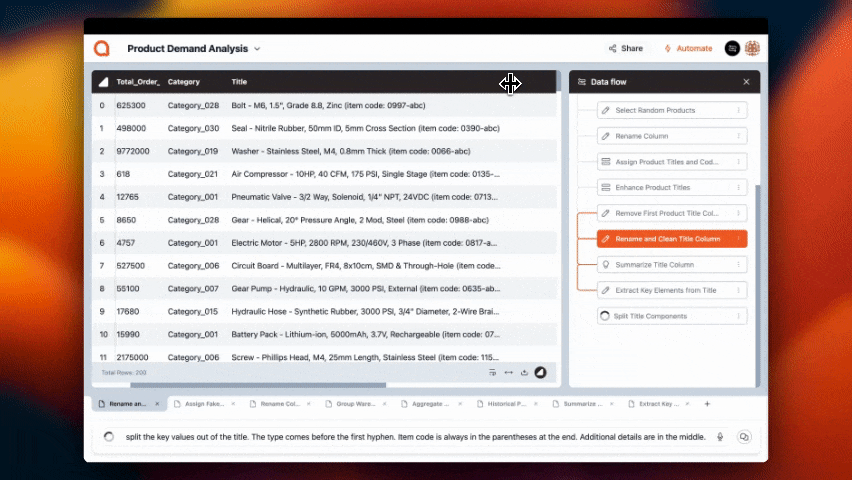Today, I’m excited to announce the general availability of Querri: the simplest way to clean, combine, analyze, and move data by asking questions in natural language.
Querri is a new kind of data platform that uses AI technology, including large language models (LLMs), to help people work with data on their own without the need for any specialized skills or access to expert resources like data engineers or data scientists.
Our aim is to empower everyone to do more with data: to make informed decisions to better run their business.

Data management takes way too much effort.
We started Querri to solve a problem that we’ve lived over and over again: Even after decades of technology investments, the organizations we’ve worked for still struggle to make the right data available for decision-making and other business needs.
At Oracle, I led an 18-month project to migrate data from more than 90 systems worldwide into one global system. Building the new system was the easy part. The hard part was cleaning the data and getting it all into the right shape to be usable once it arrived. The data cleaning and ETL tools available then (and now) would have helped, but only if:
- The data was already in just a few places
- Everyone worldwide had someone trained to use those tools or
- The global team had a good understanding of the underlying structure in 90+ systems or was able to spend months (per system) on data exploration
The world of data is not pretty. Data is stored in many different places; it’s complex and downright messy. It’s often full of duplicates, missing values, and inconsistent formats. Managing, structuring, and cleaning all this data are expensive, time-consuming tasks that may never get finished because so few people can do the work.

The software industry has been trying to make it easier to work with data since the very first computers were invented, with advancements along the way like SQL, Python, business intelligence platforms, low-code/no-code ETL tools, and more. These technologies have helped data teams work more productively, but there is still a long way to go.
Data has a language of its own… and most of us don’t speak it.
Data frames and tables, pivots, p-values, plots, and axes, joins and merges, normalization, and feature engineering: these are just a few terms that form the language of data. Today, speaking this language requires a lot of coursework and experience. It’s the realm of coders and those with ambitions to compete in Excel Esports competitions. And, it’s the price of entry for using today's data productivity tools.

Those of us who don’t speak the language of data often struggle to explain our business questions to our data-literate counterparts — if and when they have time to work on our problems. And the data professionals struggle to understand the nuances of the business, which creates a big divide:
The people who know what they want from the data aren’t the people who know how to work with it, and the people who know how to work with it don’t always know what to do with it.
When I worked at Acquia, my team used behavioral data to personalize content for website visitors. We hired incredibly smart data science people who knew a lot about building machine learning models but not much about website personalization or our customers’ desired outcomes. My team’s experience in connecting our business problems to data constructs for our data scientists was an eye-opening moment for me:
Large language models hold the key to speaking the language of data
The rapid improvement in large language models (LLMs) over the past 18 months has given us abilities that never existed before in software. Our team at Querri quickly saw the potential of using these technologies to close the data literacy divide.
Today, data scientists use an interpreter to do their work, usually a programming language like Python or SQL, to turn words into the raw ones and zeros that a computer needs to manipulate your data. Both are also still quite technical and involve a lot of looking up documentation, even for those who know how to work with them.
Now, with LLMs, we’re able to take this up a level higher and allow you to provide instructions in your native language. Your computer is able to understand whether you want a graph or want to transform your data in a variety of ways and create a pipeline. By itself, though, the LLM is just replacing the code that would perform a particular task. The user still needs to know how to do that task.

Data literacy for everyone requires both translation and guidance
It only took us a few days to build the first LLM translator, but we quickly realized that our goal needed to be much bigger. We wanted to build a data platform that would work for people who don’t speak the language of data. Querri uses artificial intelligence not only to translate instructions but also to interpret them. It actively guides the user on how to fetch, modify, reshape, and visualize their data.
An interpreter for data doesn’t just save time by writing code; it must do the hard work of understanding the data, understanding the user’s intent, and turning that intent into a set of workflows. It’s like a tour guide accompanying you to a famous historical site: Understanding your interests, curating your experience to fit your interests, and giving you helpful advice on what else to see and where to dine.
An interpreter of data that’s both transparent and intuitive
There’s no magic in Querri; when you work in Querri, you’re not trusting some AI to do your work for you. Instead, the AI in Querri allows you to ask your questions in English, takes those instructions to the underlying data science tools, and finally interprets the results back to you in easy-to-understand language.
Because we’ve created a novel way of working with data, we’ve also gone back to the drawing board on the overall user experience. We’re aiming to deliver just the right mix of simplicity, flexibility, and power to allow the average person to be able to do way more with their data than they ever dreamed of before — from exploring new datasets to building repeatable pipelines that can put repetitive tasks on autopilot.
Our beta testers have kept us focused on simplicity
Querri has now been in beta testing for just over six months. Some of our beta testers are seasoned data professionals, and others are business people with diverse backgrounds and data problems, from recruiting to financial analysis to nonprofit donor management. Over and over, we’ve heard about how surprising (and fulfilling) it is to talk to your data and get answers right back.
And over and over, we’ve seen the value of keeping Querri simple and straightforward. As tempting as it is to add more features for power users, we’re not straying away from our single conversational interface.
Our mission: data for every decision and every business process
Our mission with Querri is to give people the power to work with data on their own, regardless of their current skills or expertise. If data can drive a better decision or bring a new business process to life, we want Querri to be there.
Bring Querri on your data journey today
We think you’ll be amazed at what you can accomplish with Querri. Whether you’re cleaning up a spreadsheet, automating a sales or marketing report, doing one-off analysis, or building the next great predictive model, we’re confident that Querri will help you get there faster and with less frustration.
You can get started right away with our seven-day free trial and grow your data management capabilities with our affordable SaaS subscriptions. Your data is waiting to get to work!
We would love to hear from you!
Contact us by either scheduling a Zoom call or emailing us at hello@querri.com.
We want to understand your data challenges and help you put your data to work so your business can thrive. Messy data? Even better.